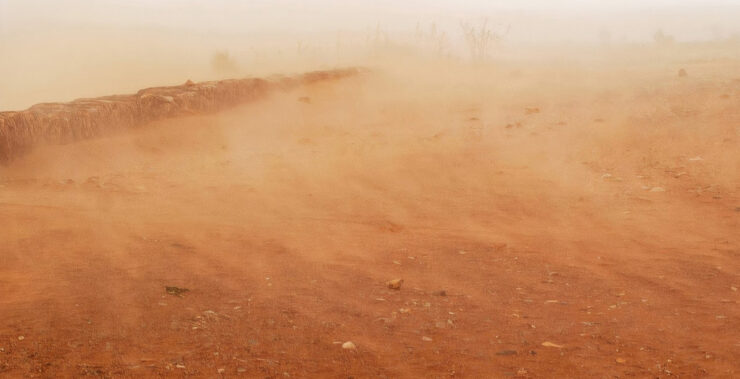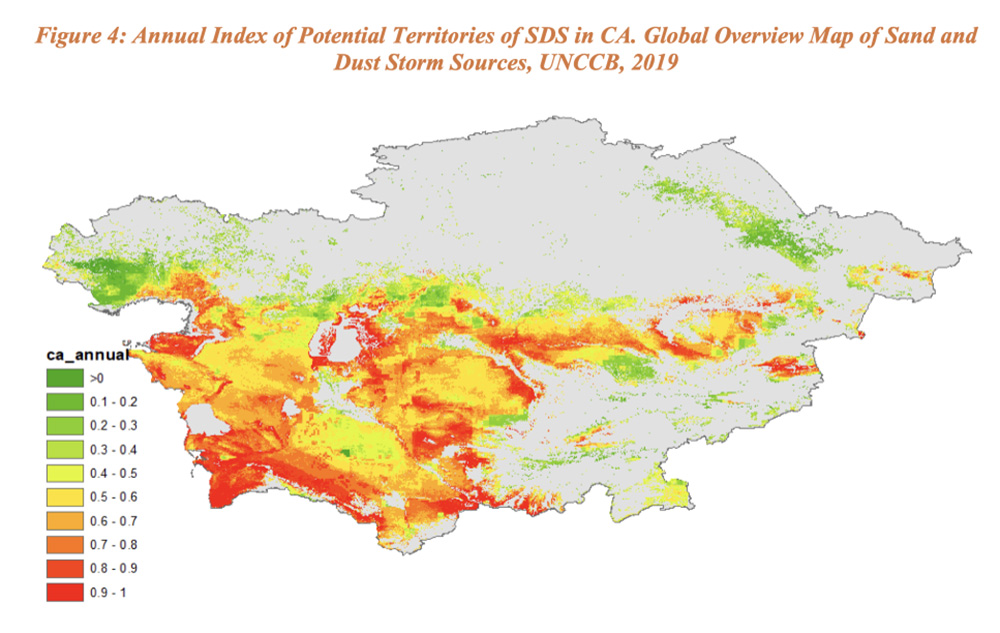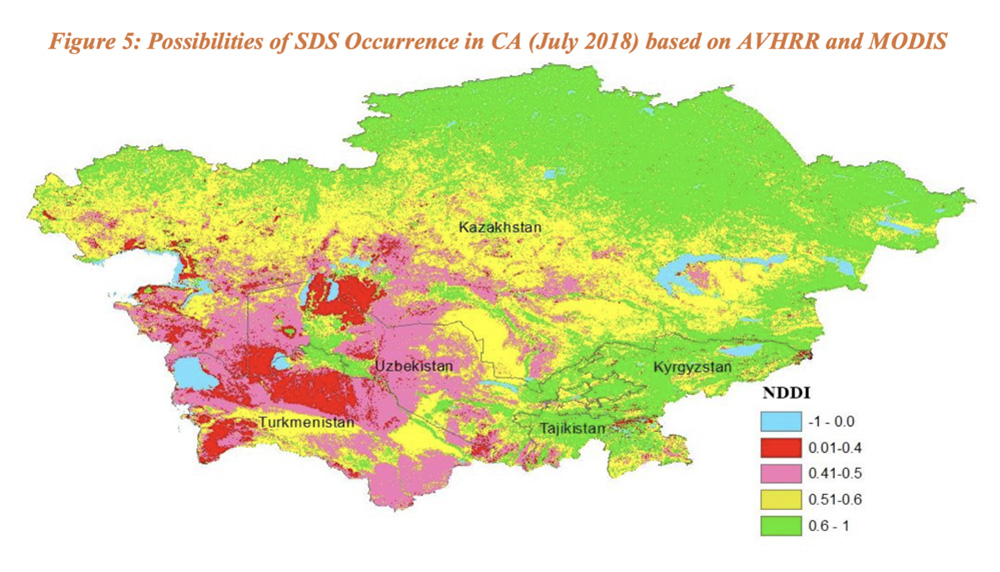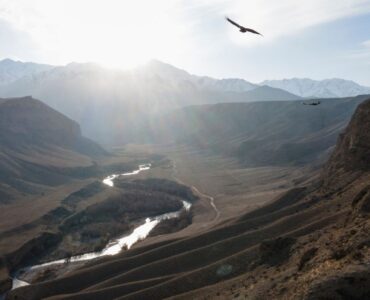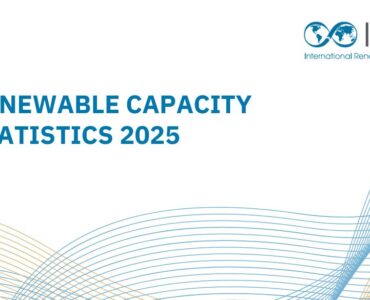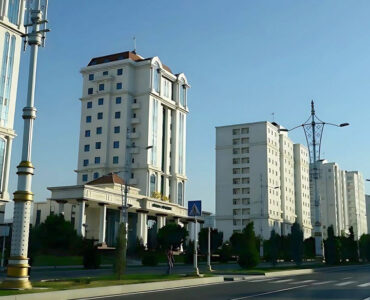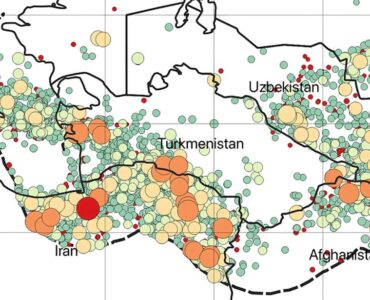The Regional Approaches for Combating Sand and Dust Storms and Droughts project by the United Nations Convention to Combat Desertification (UNCCD) presents recommendations to reduce the region’s vulnerability to the effects of sand and dust storms (SDS) and to build an institutional capacity for effective management of SDS sources in Central Asia.
The impacts of SDS are currently not documented in Central Asia, but these events negatively affect infrastructure, health, and cause economic losses. 100 million tons of dust and salt from the Aral Sea are carried away for thousands of kilometers, and cause major harm to Turkmenistan as well. More than 300 thousand people in Turkmenistan live in SDS “hot-spots”
How do sand and dust storms occur?
SDS are natural phenomena where large amounts of dust are carried by the wind from the earth’s surface several meters high, significantly worsening lateral visibility. Sand and dust can move and settle thousands of kilometers away from the source, thus making it a transboundary issue. SDS are mainly caused by multiple natural factors such as the soil structure, moisture level, and land cover, but studies have shown that dust emissions and occurrence of SDS have increased as a result of intensive and unsustainable land use and climate change.
SDS in Central Asia
In Central Asia, dust storms are usually observed in the summer, but can also be developed in the southern regions during the winter, in the absence of snow cover and precipitation. High temperatures, long-lasting droughts, limited precipitation, degraded land and vegetation cover, all lead to SDS events in Central Asia. The Karakum and Kyzylkum deserts are the largest source of dust storms in the region. The Aral Sea disaster has further led to a creation of a new active sand and dust source, with a salt desert that occupies 5.5 million ha. Dry section of the Aral Sea sees more than 90 days of dust storms, and transports more than 100 million tons of dust and salt over thousands of kilometers away, affecting 73 million people in the region.
In Turkmenistan, SDS events form in winter mainly in the east and southeast when wind speeds reach 2.8-5.1 m/s, whereas in the summer SDS are more prevalent in the west, southwest, and center of the country when the speed reaches 3.5-5.1 m/s, according to the monthly average data for 1981-2010. Studies have shown that there are 300-400 mg of dust particles in 1 m3 of air in Turkmenistan.
According to an SDS source Basemap developed by the UNCCS, large areas of Turkmenistan are SDS source and the occurrence rate of SDS is very high in the country.
Source: UNCCD, 2021
Risks
SDS events are associated with many negative impacts. For example, they affect transport, industrial plants, power plants, communications, agriculture, and other infrastructure. SDS also have a negative impact on people. For example, there are several “hot spots” in Turkmenistan alone, such as Zaunguz Karakum, Western and Northwestern Karakum, with about 308 thousand people residing in areas with high population density and high SDS occurrence. SDS has severe impacts on the health of the exposed populations. As the Aral Sea disaster has shown, incidence of anemia, asthma, typhoid, and acute respiratory infections all increase as a result of exposure.
There are also economic risks, although they are not calculated by any of the Central Asian nations. The risks are usually not direct, but considering the impact of SDS on agriculture alone, loss of production can severely impact livelihoods of people and their financial well-being.
Current measures
As of today, SDS early warning system development has just started, with only regulatory acts being adopted and some first steps to collaborate, as a region, have been made. For example, the National Institute of Deserts, Flora, and Fauna in Turkmenistan (no website) engages in research activities around the topic of SDS with the Institute of Geography and Water Security in Kazakhstan. In total, more than 29 international environmental conventions have been signed. Most of the organizations are joined on a national level and do not transform into regional cooperation.
Countries in Central Asia already take some measures such as stabilization of drift sands, afforestation, creation of underground freshwater reservoirs, etc. Studies have shown that protective forest belts can reduce wind speeds significantly and also increase relative humidity of air.
Kazakhstan and Uzbekistan are working on rehabilitation of the dried bottom of the Aral Sea in their own parts of the Aral Sea Basin. Uzbekistan has created 1.5 million ha of plantation in 2017-2021, and Kazakhstan has planted 1.8 million shrub nurslings.
The strategy priority areas
The Strategy highlights three key priority areas:
- Strengthening knowledge about SDS. Enhancing understanding of the impacts of sand and dust storms on economic sectors and on the population will help to address the impacts locally and regionally.
- Mitigating the impact of anthropogenic sources of SDS. The measures should be designed at the community and farm level, with the help of leading universities specializing in agriculture and natural resources.
- Regional cooperation should be enhanced as the issues that Central Asian nations are facing are transboundary. Governments should join forces and finance projects related to environmental problems.
The authors of the report recommend that this Regional Strategy be incorporated by the Interstate Committee on Sustainable Development, who will be responsible for monitoring and reporting on implementation of this regional strategy.

